There is no replacement for shot placement.
I THINK I just made that little tagline up, but I’m not sure.
Either way, it’s 100% true and here’s why:
There is no bullet, gun or piece of gear that can make up for poor performance. Specifically, in the case of defensive use of a firearm, shot placement is absolutely the #1 most important part of stopping an attacker.
Shot Placement, Not Caliber, Is King
In the firearms world there is a lot of debate as to the “best caliber” both in handguns and in rifles.
A lot of gun guys don’t like 9mm’s because they think the .45 ACP is superior and that a 9mm won’t reliably stop a threat. (Even though with modern defensive ammunition all service calibers — 9mm, .40 S&W, .45 ACP — perform about the same.)
In rifles, there’s a lot of gun guys that still don’t like the standard AR-15 cartridge — 5.56 NATO/.223 Rem — calling it a “poodle shooter” or pointing out it’s considered a varment round for hunters (even though, again, it’s not only proven itself through multiple wars, but proper ammunition makes this round even more capable.)
And of course one guy says he’ll never trust his life to a .380 … but other guys say that any gun is better than no gun.
The arguments go on and on …
But the truth is that shot placement, aka, hitting a vital target is KING and it always will be.
If you can do that — almost all calibers will achieve the objective of stopping a threat.
CASE STUDY: Alaska Outfitter Kills Raging Grizzly With 9mm Pistol
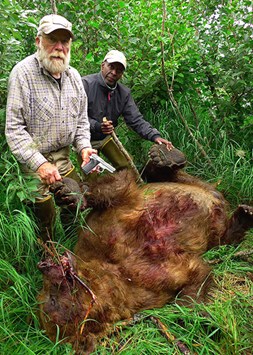 A buddy of mine sent me this awesome story about an Alaskan outfitter who defended fishermen from a raging grizzly and killed it with his 9mm pistol.
A buddy of mine sent me this awesome story about an Alaskan outfitter who defended fishermen from a raging grizzly and killed it with his 9mm pistol.
That’s right, a little 9mm pistol.
Not even a big, manly caliber like .45 ACP!
Phil Shoemaker (the guide) starts his report by saying (emphasis mine):
“I have killed enough bears to know how important shot placement can be, even with large-bore rifles. I was well aware of the limitations of my 9mm pistol, even with Buffalo Bore ammo. I was aiming for a vital area with each shot; because it all took place between 6 and 8 feet, they were not far off. But hitting the head and brain of a highly animated and agitated animal is a difficult shot.”
Did you get that?
Shot placement is critical … even with … big, manly “large-bore rifles”. So there’s no replacement for accuracy.
Now let’s get to the awesome story …
“The bear was highly agitated and standing within 3 feet of my clients when I decided I could take a shot without endangering them.
“My first shot was at its neck, and then it began growling and spinning toward the impact. I wanted to hit the head but the bear was moving so fast I simply began shooting each time I could hit a vital area. I hit it six times before it turned to run off, and my seventh shot was into its pelvis area as it ran. When it dropped within 6 feet of the last shot, I checked my pistol and found I had only a single round left in the chamber so decided against walking in and finishing it.
“My pistol was loaded with Buffalo Bore 9mm +P Outdoorsman 147-grain FN hard-cast loads that have a muzzle velocity of 1100 fps. I had previously tested, compared and proven such loads with my .357 and .44 mags., and I was convinced they would work.”
Practice Accuracy Because It Can Save Your Life
If you have to use a gun to defend your life or the life of someone else, then accuracy and shot placement are absolutely critical.
You need to aim for vital targets, and shoot them as many times as needed, until the threat stops being a threat. That’s why you should practice face shots.
Accuracy is vital. Combat accuracy, or being able to get multiple, good hits, at speed is the key. Here’s how to practice combat accuracy and a more complete discussion of shot placement and what are vital area targets on the human body.
It won’t matter what kind of whizzbang gun or caliber you’re packing if you can’t hit what you’re aiming at. So make sure you practice more than you argue over ammunition.

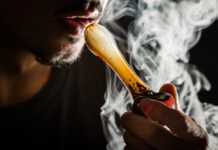



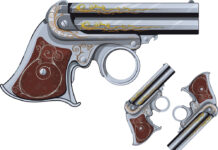




![What Level Holster Should You Be Using? [Video]](/wp-content/uploads/2024/04/Depositphotos_44548439_S-218x150.jpg)
![Case Study: Defensive Gun Use [Video] NSFW](/wp-content/uploads/2025/07/Depositphotos_282075792_S-218x150.jpg)







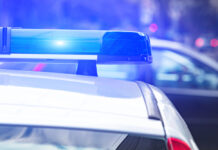
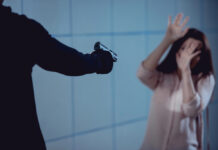
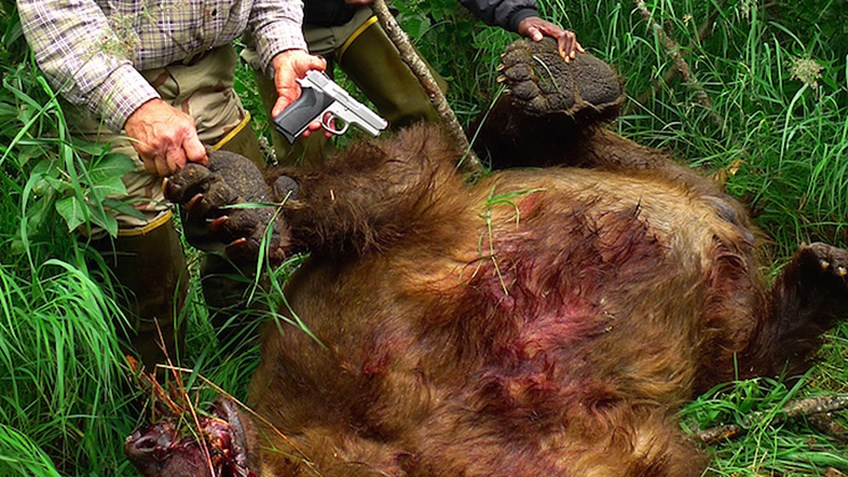



![SCARY Impressive Firearm Alternative? [Video]](/wp-content/uploads/2023/12/Screenshot-2023-12-25-9.11.02-PM-100x70.png)





![Optic Ready vs Milled slides? [Video]](/wp-content/uploads/2024/02/image-3-100x70.png)
![[Checklist] What Gear You Need To Take Pistol, Rifle & Shotgun Training Courses [Video]](/wp-content/uploads/2023/07/Depositphotos_275087632_L-100x70.jpg)
![What is in Carter’s 2023 EDC? [Video]](/wp-content/uploads/2023/07/Depositphotos_146856137_L-100x70.jpg)



Not to take away from his dropping the bear but that looks like a baby cinnamon.
Pretty small for a grizzly, must have been the runt of the litter. I keep wondering why would an Alaskan guide carry a 9mm to begin with? If it were me I would probably be carrying a 10mm Glock 20!
Regardless of size, this type of animal can kill or maim you quickly, hesitation and poor shot placement will leave you in a world of hurt.
Really, a baby cinnamon? Look at the front paw he’s holding in his hand…it’s 3 times bigger – at
least – than the guide’s hand. It’s mostly likely a 3 year old and not a full grown grizzly, but it could still kill ya with one swipe of that huge paw with those nasty claws!
Very impressive, and the story shows a high degree of relative calm with the guide in what must have been a terrifying situation. I could certainly train even more to help ensure I could be maybe as calm under that kind of pressure – or worse (as in defensive shooting with a human as the threat that needs to be stopped). Regardless, the point re: shot placement is well taken. MY EDC is a Glock 40 caliber, which I feel is a bit heavier a caliber than I really need, but… My wife’s EDC is a .380, and she is a great shot – with paper targets at least. We do get in our practice time, although it is high time for another defensive handgun class just to re-re-reinforce the training that will hopefully help in a pressure situation – something we hope to never have to deal with in the first place.
In any event, shot placement is crucial, I agree fully. But so is training, training, training, and refresher training just to help hone the skills needed when terror and fear enter the real life scenario with a life threatening situation, and logical thought is not at hand to help. Survival will come down to good equipment, and training – to include shot placement. That said, even more important are the daily decisions we make with strong consideration to avoid potentially dangerous situations to begin with. Just because we think we are well prepared to defend ourselves does not mean we want to have to. The best placed shot is the one we do not have to make – IMHO.
Absolutely agree on all points!
Both he and the client were fortunate, that does not look like a full size grizz, a animal that demands great respect and a hell of impact to slow it up…never the less, good shooting……
Reminds me of that short lived club where to be a member you had to kill a bear with a knife. I guess it could be done, but there are better ways of going about it. 🙂
LOL
Listen to those who make light of the size of the griz. I live in the Pocono Mts. of PA, where we only have black bears, thank God. These bears are mostly inoffensive, I have had the opportunity to observe them in the woods. I am about 5′ 10″ and 215 lbs. I did hard physical work most of my life, driving a truck and loading or unloading up to 50,000 pounds at a clip, etc. . What I have observed in the woods watching the bears, I would not want to fight even a 100 lb. bear. So unless you have actual experience with bears don’t underestimate them, it could be dangerous. The largest bear up here was taken behind the NASCAR track had and estimated live weight of 834 lbs. Now as to caliber, I would carry no less then a 454 Casull or a 500 S&W handgun. Phil Shoemaker is a noted Alaskan guide who has many verified griz encounters. If he feels comfortable with a 9mm, for one would not criticize his choice. Unless you hit a vital spot a 50 cal Browning will do you no good. I prefer the 45ACP for self defense. A good balance between accuracy, stopping power, and recoil. I all I had was a 22 rimfire I would not feel undergunned. I would just practice more, so that I could guarantee a face shot or other vital hit every time. Just my 2 cents.
Right? Bears or sharks … I’m not concerned about how “small” they are … no thanks!
Not only being able to hit the vitals, but knowing where they are… And it’s moving fast and toward you… I’d guess you either freeze up or shoot it like a pop can and the adrenaline all comes later.
I was shooting a borrowed .22LR SA Colt style 6″ the other day. Even left handed I was able to get 2″ group at 5 yards. And I thought, a rational bad guy would not want shot, no matter the caliber. The .22 would be a fine choice if you knew for sure you could hit what you wanted to.
It’s the irrational bad guys (or bears) where that argument falls apart a bit. And I suppose a lot of the bad guys and most of the bears are in that category.
…And a note on face shots (Bud), one bad day early in my hunting career I learned that face shots to a deer don’t result in instant death. Was intending to put down a one-shot-and-down-but-not-done doe. Turns out it takes more than a face shot – it takes a brain or spine shot. That was from 5′ with a .50 round ball over 100g of FFg, 2x before I realized that I was not putting her out of her misery or missing, I was just hitting non-vital face area. The hot ticket is the spinal column. The heart (first deer ever) will still allow them to run 60y before they run out of oxygen. A spinal column shot will drop the biggest buck without even a step. I would be keeping that as my prime target on any bear or whatever else that was after me if I really wanted it down fast. But I’ve never been around bear hunting, so would guess it would take a whole lot of penetration to get there, so you’d want to go for the neck, but really aiming at the spine. I know that was the old muzzle loader plan. one shot, make it count, wait for them to rear up and swipe you and then discharge into the neck…
Stats claim 7 of 10 shots from trained LE in excited situations are misses and the fact that the FBI has gone back to 9mm should be enough to convince most that gun control i.e. shot placement is more effective than stray canon rounds
Great points Bill
Just saw this…
http://www.newsmax.com/US/US-Face-Biting-Attack/2016/08/17/id/743918/
I guess this is a good argument against low energy self defense rounds… That something like this could even happen is beyond me. There is no rational thinking here. Only wild craziness.
Yeah he is LUCKY the bear spun instead of charged him after the first shot…a full grown male would probably have charged and we would be reading his obituary (and his clients)! I do believe shot placement is king, but he had to empty the gun (except 1 round) to kill it. If it was a full grown male he would not have. Totally irresponsible to carry such a light weapon when your job is to protect your clients. Just my opinion….the guy got EXTREMELY lucky.
IF you read the actual article he makes clear why he decided to carry a 9mm that day.
Although it is a light caliber for such an animal, a 147 gr. hard cast bullet at 1100 fps would penetrate fairly well… i for one if carrying that light of pistol, would have something with bigger, heavier loads as a 1st. gun… those critters are tough and not all run the other way..
I was taught these things a long time ago. It really surprises and upsets me the number of people that I know and just talk to, that believe, bigger is better, and shot placement and practice are secondary. Great article.
Nice article. Placement is final, but one should remember: It is much better be missed by .44 than be hit by .22!
Comments are closed.